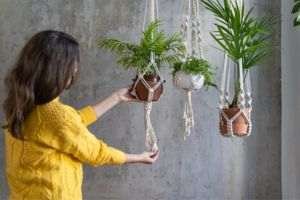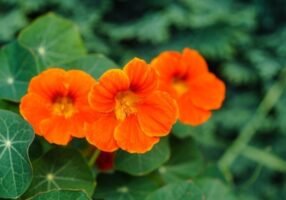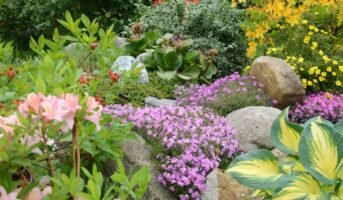Gardening, a therapeutic activity cherished for ages, has evolved over time. While traditional methods involve soil or terracotta pots, modern plant enthusiasts seek creative ways to bring greenery indoors. Whether you’re a seasoned gardener or a novice plant enthusiast, adorning your windows skills or tables with indoor hanging plants can add a refreshing vibe to your interiors.
These plants enhance the aesthetic appeal of your home and promote healthier indoor air. Perfect for urban dwellers and those with limited outdoor space, hanging plants are both space-efficient and visually striking. This comprehensive guide will explore various aspects of indoor hanging plants.
Indoor hanging plants: Key facts
| Fact | Description |
| Growing medium | Typically grown in hanging baskets or planters with attached rope structures for suspended display. |
| Appearance | Dangling stems, branches, and delicate leaves; ideal for compact spaces like balconies and indoor settings. |
| Sunlight requirement | Varied – some thrive in bright, indirect sunlight, while others prefer partial shade. |
| Container options | Hanging baskets, terracotta pots, or containers with wall-mounted brackets for indoor or outdoor use. |
| Propagation | Most reproduce through seeds or spores, while some, like air plants, absorb nutrients and moisture from the air. |
Types of indoor hanging plants in India
Boston Fern (Nephrolepis exaltata)
Known for its distinctive arching fronds, the Boston Fern adds greenery to indoors spaces. With slightly serrated, and tiny leaflets, it grows in bright, indirect sunlight. Ideal for hanging baskets.
Care Tips: Requires moist soil, regular pruning of brown fronds, and grows in high humidity.
Benefits: Adds frilly greenery to indoor spaces, is slow-growing, and is suitable for both indoor and outdoor settings.
String of Pearls (Senecio rowleyanus)
With cascading bubble-shaped leaves, String of Pearls is a stunning succulent belonging to the daisy family. Its long, wiry stems create a mesmerising effect, making it a favourite for hanging containers. Perfect for ceramic pots and known for its unique appearance.
Care Tips:
- It demands moist soil.
- Grows in indirect bright sunlight.
- Produces tiny white flowers with a cinnamon-like scent.
Benefits: Insta-worthy appearance, a unique combination of succulent and vine, easy to grow.
Air Plants (Tillandsia)
Highly versatile, with minimal care requirements, Air Plants are easy to keep and absorb atmospheric nutrients. Suitable for glass capsules or macrame hanging plant holders.
Care Tips:
- Grows on minimal care.
- Absorbs nutrients and moisture from the surrounding atmosphere.
- It is suitable for various hanging setups.
Benefits: Low-maintenance, resilient, ideal for forgetful gardeners, adaptable to different hanging arrangements.
Bird’s Nest Fern (Asplenium nidus)
Known for its spiral arrangement of evergreen fronds, the Bird’s Nest Fern is an epiphytic plant that grows well in bright, indirect sunlight. It forms a nest-like structure as its fronds turn brown.
Care Tips: Grows well in bright, indirect sunlight, with fronds becoming more crinkled in higher light conditions.
Benefits: Unique fern variety with an attractive appearance, suitable for both indoor and outdoor spaces.
Golden Pothos (Epipremnum aureum)
An evergreen plant with heart-shaped leaves and random yellow splashes, Golden Pothos, is versatile and can be trained on poles or walls. It climbs and twines, making it an ideal choice for hanging pots or containers.
Care Tips: Low maintenance, thrives in hanging pots, glossy green foliage, and twining habits.
Benefits: Versatile and hassle-free plant, effective air purifier, suitable for various hanging setups.
String Of Bananas (Curio radicans)
Trailing stems with banana-shaped leaves, String of Bananas is a succulent that adds a unique touch. It is ideal for hanging baskets and thrives in warm weather.
Care Tips: Easier to grow than its sibling, the string of pearls is suitable for warm weather conditions.
Benefits: Unique foliage, easy to propagate, ideal for hanging baskets and trailing displays.
Baby’s Tears (Soleirolia soleirolii)
Delicate, spreading leaves on thin stems, Baby’s Tears form a dense mat. It is ideal for terrariums and bottle gardens, requiring less sunshine.
Care Tips: Spreads quickly, bears white star-shaped flowers during summers, and is suitable for terrariums and bottle gardens.
Benefits: Dense growth with tiny leaves adds a fresh and lush look to hanging setups.
Burro’s Tail (Sedum morganianum)
Stylish and eye-catching, Burro’s Tail has trailing stems with thick, juicy leaves in a braided pattern. It is ideal for creating a controlled jungle effect.
Care Tips: Requires full sunlight, ideal for creating a controlled jungle in hanging setups.
Benefits: Eye-catching and funky appearance, easy to grow, suitable for hanging on balconies or patios.
Spider Plant
With spindly, bright green leaves striped white, Spider Plants thrive in hanging planters due to their cascading growth, producing small white flowers in bright daylight.
Care Tips: Low-maintenance and suitable for various locations.
Benefits: Hassle-free, easy to care for, and suitable for various hanging setups, air-purifying properties.
Wall hanging plants: Care tips
Choosing hanging baskets
Select suitable baskets, considering material, climate, and plant type. In hot regions, opt for hanging terracotta pots to prevent soil overheating.
Understanding growth prerequisites
Different hanging plants have varied needs. Provide adequate light, nourished soil, and hydration per each plant’s requirements.
Basket preparation
Ensure hanging baskets have lightweight soil and proper drainage holes to create a comfortable environment for your plants.
Good fertiliser
Use a balanced liquid fertiliser to provide essential nutrients. Incorporate coconut products like coco peat and coco chips for improved soil quality.
Regular trim sessions
Prune your hanging plants regularly to maintain their shape and remove dead growth. Trimming promotes new growth and keeps the plants looking fresh.
Indoor hanging plants: Benefits and Uses
Space-efficient greenery
Ideal for urban dwellers and those with limited space, hanging plants maximise greenery without occupying floor space.
Enhanced interior aesthetics
Hanging plants serve as attractive decor pieces, adding texture and colour to interiors.
Air purification
Many hanging plants, such as English Ivy and Spider Plant, act as natural air purifiers, contributing to a healthier indoor environment.
Low maintenance
Several hanging plants, like air plants and Golden Pothos, are low-maintenance and require minimal care.
Online accessibility
Purchase live hanging plants online, conveniently choosing from a variety of options available at affordable rates.
Incorporating indoor hanging plants elevates the living space aesthetically and offers several benefits. From air purification to space-efficient greenery, these plants are low-maintenance and enhance the home’s interior. Easy-care options like Air Plants and Golden /pothos make them ideal for busy lifestyles. Various online options make it convenient to bring nature indoors affordably.
FAQs
Can I grow wall-hanging plants indoors?
You can grow indoor hanging plants in various settings, including homes, balconies, terraces, and more.
Do hanging plants dry out faster?
Yes, hanging plants drain faster as they hang in the air, allowing water to escape quickly. Adding coco baskets at the bottom can enhance moisture retention.
Is it hard to grow hanging plants?
No, growing hanging plants is relatively simple, provided you offer them the right conditions to flourish. Understanding their specific needs is key to successful growth.
How often should I water-hanging plants?
Watering frequency varies depending on factors like the plant species, season, and local climate. During summers, more frequent watering may be needed, while in other seasons, adjust based on soil moisture.
Can hanging plants survive in low light conditions?
Yes, some hanging plants are adaptable to low light conditions, making them suitable for indoor settings with limited natural light.
Do hanging plants attract pests?
While hanging plants are not immune to pests, regular care, monitoring, and appropriate preventive measures can help keep pest issues under control.
Are hanging plants suitable for small spaces?
Yes, hanging plants are perfect for small spaces, including balconies and indoor areas. Their compact and cascading growth adds a touch of greenery without taking up much space.
| Got any questions or point of view on our article? We would love to hear from you. Write to our Editor-in-Chief Jhumur Ghosh at jhumur.ghosh1@housing.com |
Nisha A Rawat, diligently tracks the residential real estate trends and offers valuable insights in her articles. She’s skilled at making real estate terminology easy to understand, ensuring accessibility for all. Nisha’s articles are well-researched and analytical.












